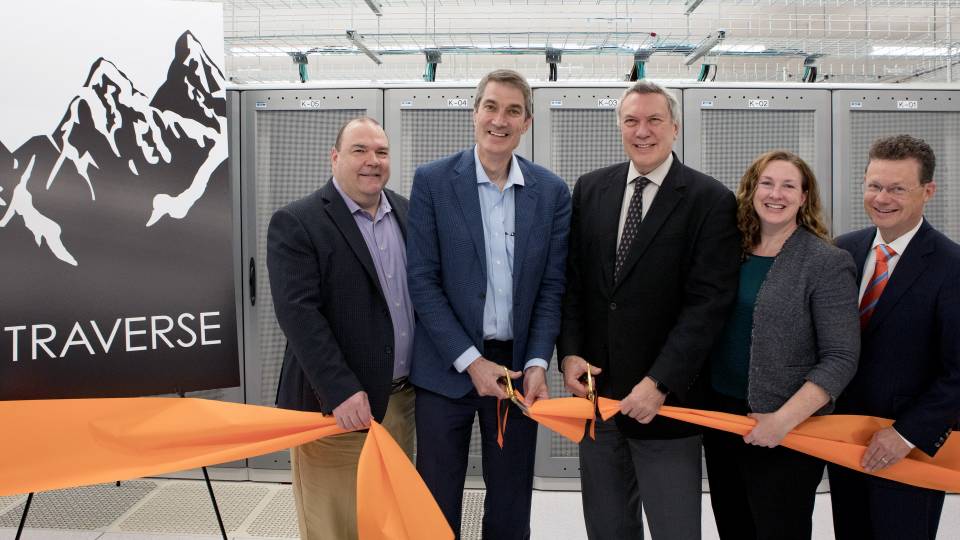IBM, University pair to bring 'Blue Gene' to campus
A unique partnership between Princeton scientists and information
technology administrators has brought one of the world's fastest
supercomputers to the University to spur advancements in research.
Working with IBM, the University's Office of Information Technology
(OIT) collaborated with Princeton researchers to purchase and install a
"Blue Gene" high-performance computer that will aid current and future
research solving complex problems in areas including astrophysical
sciences, engineering, chemistry and plasma physics. The University
plans a ribbon cutting Nov. 22 to inaugurate the computer that was
installed last month.
"We are excited about the possibilities for collaborative research
among faculty that this extraordinary resource will allow," said Betty
Leydon, Princeton's chief information officer and vice president for
information technology. "Having OIT, the Princeton Institute for
Computational Science and Engineering, the School of Engineering and
Applied Science, and several individual faculty members contribute to
the cost shows that we all recognize the value of working together to
build the best possible IT infrastructure to support research at
Princeton."
Princeton expects its new supercomputer to claim a spot in the top 100
of the world's highest performing computers on the "Top500
Supercomputer Sites" list that will be released by the computing
industry next week.
Fewer than 10 other U.S. universities in the top 100 have
supercomputers on their campuses not affiliated with federal agencies,
according to the 2005 Top500 list compiled by computing labs at
Germany's University of Mannheim, the University of Tennessee and the
Office of Science in the U.S. Department of Energy.
"This supercomputer should enable research that will help Princeton
build its reputation as a computational research center," said Maria
Klawe, dean of Princeton's engineering school. "We will now have
advanced resources for researchers who need them to process data for
highly complex operations."

The new supercomputer should also position the University to be a better funding target for science and research organizations attracted to institutions that can demonstrate the greatest computing efficiency, according to Curt Hillegas, manager of computational science and engineering support in OIT's academic services department.
"More of the funding can go directly to research because we have already pooled our resources to support the computing infrastructure needed for projects," said Hillegas, who has been leading the effort to provide centralized computing support to University researchers.
Blue Gene, named for the genetics research for which it was initially designed, is made up of 2,048 processors. It calculates problems almost 1,000 times faster than a typical desktop personal computer and allows researchers to partition it to use part of its capacity for less complex jobs or multiple tasks.
Astrophysics problems that involve modeling the universe, for example, or aerospace engineering computations to determine the forces that might act on the wing of a jet plane could occupy one part of the Blue Gene, while another part is modeling a chemical system that might require different processing capacity.
"The decision about what type of computer we would acquire was really done with the faculty taking the lead because they know what they need to model complex interacting forces," said Serge Goldstein, director of the academic services department in OIT. "This new computer will be available initially to the researchers who contributed funding as we get familiar with it, and then we'll make it available through an application process to the general campus community in a couple of months."
A little larger than a refrigerator and assembled and tested by engineers in IBM’s Rochester, Minn., facility, the Blue Gene that administrators plan to call "Orangena" -- to incorporate aspects of its original name and one of Princeton's colors -- was installed for early testing by IBM engineers and consultants on Oct. 18 in the computing center at 87 Prospect Ave. on Princeton's campus.
The University had been working for three years to centralize computing support for researchers who typically have had to buy their own computers, and began working with IBM to bring the Blue Gene to campus last spring. Researchers selected IBM for the company's potential as a future partner in collaborative research, in addition to the features of its supercomputer.
"IBM Blue Gene has once again risen as the computational system of choice to tackle some of the most compelling, demanding problems facing scientists today," said Dave Turek, vice president of Deep Computing at IBM, the world's largest information technology company. "Princeton's important areas of study, such as astrophysical sciences, engineering, chemistry and plasma physics, are ideal applications for the world-record performance of the Blue Gene Solution."
While the Office of Information Technology paid for about half of the new Blue Gene in a unique collaboration, the Princeton Institute for Computational Science and Engineering, the School of Engineering and Applied Science and individual faculty members made significant contributions toward the purchase.
"My involvement began because I saw a use in my research for demanding computations in predicting structures for protein folding, computations in metabolic networks and other areas," Professor of Chemical Engineering Chris Floudas said.
Floudas is one of seven Princeton researchers who contributed personal grant funds to help buy the supercomputer. Academic administrators, such as Klawe of the engineering school, also supplied funds to support the research of their faculty.
William Tang, the chief scientist at the Princeton Plasma Physics Laboratory and a professor of astrophysical sciences, said he played a key role in selecting the Blue Gene because of the potential it will unleash for bringing scientific advancements about more quickly.
"Just because you have these super fast computers doesn't mean they're going to benefit society in any specific way, unless you're going to use them to accelerate the progress of scientific discovery," Tang said. "If you can accelerate the process of scientific discovery in a very cost effective way, everyone benefits."


